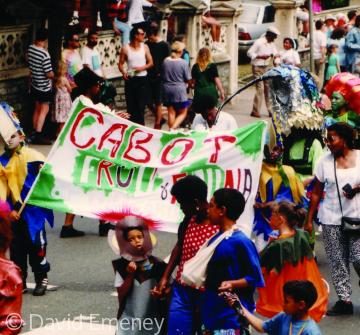People and Communities
 Street scene at St Paul's Carnival, Bristol, c.1990
Street scene at St Paul's Carnival, Bristol, c.1990People and communities lie at the heart of local history. Although the rich and famous dominate the lives of ordinary people and communities are of equal interest. A surprising number of sources from the Middle Ages onwards are concerned with ordinary people and their lives.
Until the 18th-century most people lived in agricultural communities and small trading towns. Geography determined the type of community. In upland areas many lived in isolated farmsteads and small hamlets and in lowland areas large village communities were more common. Community resources were shared, events were celebrated together and relationships were formed. Despite formal bodies such as the manor court or the church pre-industrial communal life probably depended on relationships between people connected by blood or marriage.
Although slavery had technically disappeared from England after the Norman Conquest large numbers of people, including prosperous ones, owed part of their labour to their landlord and were regarded as 'unfree'. They could be bought and sold with the land. They lived alongside tenants who paid rents and freeholders, craftsmen and manufacturers. Priests and religious communities formed a substantial part of the medieval population. Later these were replaced by parish clergy of several denominations, as nonconformity grew, teachers, lawyers and bureaucrats.
Town inhabitants were regarded as free although there is evidence of bonded service. As urban life grew from the later Middle Ages the range of retailers, manufacturers and professional people expanded. Most worked for themselves and employed servants, journeymen and apprentices drawing young people into the towns. Landowners often had a second residence in London or other cities. Better-off urban populations craved entertainment and although villages had public houses and travelling entertainers town communities increasingly supported theatres, dances, concerts, circulating libraries, museums, art galleries, and learned societies.
After the Industrial Revolution labourers and their families flocked to work in the mills and the mines creating new industrial communities. Self support groups improved the quality of life. Newspapers, libraries and cheap books encouraged literacy and reading at most levels of society and spread ideas. Commercial entertainment included circuses, music halls and cinemas.
The growth of government meant that from the 19th century few communities have escaped scrutiny. The new media of film, radio and television widened the sense of community from parish and town to nation as the country was devastated by two World Wars. Migration brought ethnic and cultural diversity. By the 21st century access to entertainment and information at home and the loss of traditional industry may be creating new forms of virtual community.










